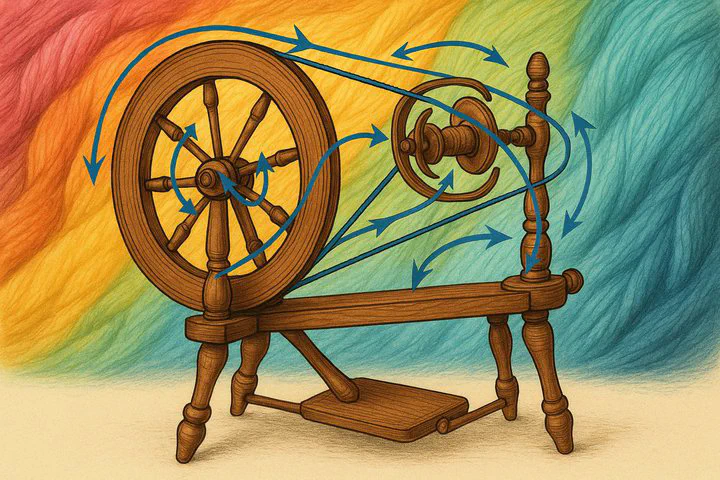Solving Double Drive Spinning Wheel Issues

Are you struggling with your double drive spinning wheel and not sure where to start? You’re not alone! Every spinner runs into problems now and then. In this guide, we’ll break down how these amazing wheels work, tackle the most common double drive spinning wheel issue you might face, and show you quick fixes so you can get back to making beautiful yarn.
TIP: If you learn best by seeing things, add simple sketches or photos as you read. A picture of the drive band path or the flyer parts can make the steps even clearer.
Understanding Double Drive Spinning Wheels
Have you ever looked at your wheel and wondered how all those parts fit together? A double drive spinning wheel has one long drive band that loops around the drive wheel twice—once on the flyer whorl and once on the bobbin (often called the spool). When you treadle, the wheel turns the band, and the band turns both the flyer and the bobbin at different speeds. This setup lets you spin yarn smoothly and evenly.
Because both loops use the same band, tension is easy to fine-tune. Many spinners like double drive wheels for making fine, delicate yarn. The wheel gives gentle pull-in, so your fibers don’t break. It also lets you change ratios quickly by slipping the band onto a larger or smaller groove. That’s handy when you switch from wool to something trickier like silk.
But every good tool can have problems. A common double drive spinning wheel issue is when the band stretches or slips, and the spool turns slower than wool spins. Sometimes the spindle is screwed to the drive wheel too tightly, making everything drag. If you own an older wheel, you might face a special antique spinning wheel double drive issue, such as brittle leather bearings or misshaped grooves. These troubles can keep your yarn from winding on and leave you feeling stuck.
Now that you know how the system works, let’s look at the problems you might meet and how to fix them fast.
Troubleshooting Common Problems
Don’t worry if your wheel is acting up—most fixes take only a few minutes.
-
Check the drive band.
• Is it loose, shiny, or fuzzy? A stretched band is the most common double drive spinning wheel issue. When the band slips, the spool turns slower than wool spins, so the yarn piles up on the flyer. Replace the band or twist it tighter.
• Move the band to a smaller groove on the bobbin or a larger groove on the flyer. This boosts take-up so the spool needs to turn faster and wind on the yarn. -
Look at the flyer assembly.
• Sometimes the spindle is screwed to the drive wheel too hard. This creates drag. Gently loosen the screw until the flyer spins freely but has no side-to-side wobble.
• Add a drop of spinning-wheel oil to the metal points or leather bearings. Spin the wheel by hand; it should coast for several seconds. -
Inspect older parts.
• A groove worn into a strange shape, dried-out leather, or a bent flyer can trigger an antique spinning wheel double drive issue. Sand rough spots with fine sandpaper and rub in a little beeswax. Replace cracked leather with fresh pieces.
• After each repair, spin a short test length of yarn to see if the problem is gone.
Keep a simple checklist nearby: tighten or replace the drive band, oil moving parts, and balance the tension every time you sit down to spin. With these steps, you’ll turn any double drive spinning wheel issue into a quick win—and get back to making the yarn you love.
Ensuring Your Spool Turns Faster
When your spool needs to turn faster, start with the simplest fix: band tension. A tight, springy drive band keeps the bobbin ahead of the flyer, so yarn winds on without a fight.
-
Tighten the mother-of-all (the bar that holds the flyer) a quarter turn. Treadle a few strokes. If the spool turns slower than wool spins, tighten a bit more until the pull-in feels steady and gentle.
-
Switch to a smaller bobbin groove. A shorter path makes the bobbin spin faster. This easy swap often clears up a stubborn double drive spinning wheel issue in seconds.
-
Reduce friction.
• Pop the bobbin off and wipe away lint or old oil. Add a fresh drop of oil to each bobbin end.
• If the spindle is screwed to the drive wheel too tightly, loosen it just enough so the flyer spins without wobble. -
Care for the drive band. Gently wax a cotton band or rub in rosin for better grip. If your wheel is old, a dry band may slip, causing another antique spinning wheel double drive issue. Replacing the band with fresh string is quick, cheap, and can make the spool race like new.
Try one change at a time and test often. With practice, you’ll know exactly how much tension, oil, and groove size you need. Soon the bobbin will spin fast, the yarn will wind on smoothly, and every treadle will feel like a tiny victory.
Wrapping Up: Keep Spinning with Confidence
Remember, every spinner faces challenges, but with a little patience and practice, you can overcome any double drive spinning wheel issue. By understanding your wheel and making small adjustments, you’ll solve problems quickly and get back to creating the yarn you love. Keep experimenting, stay curious, and soon you’ll be spinning like a pro. Happy spinning!